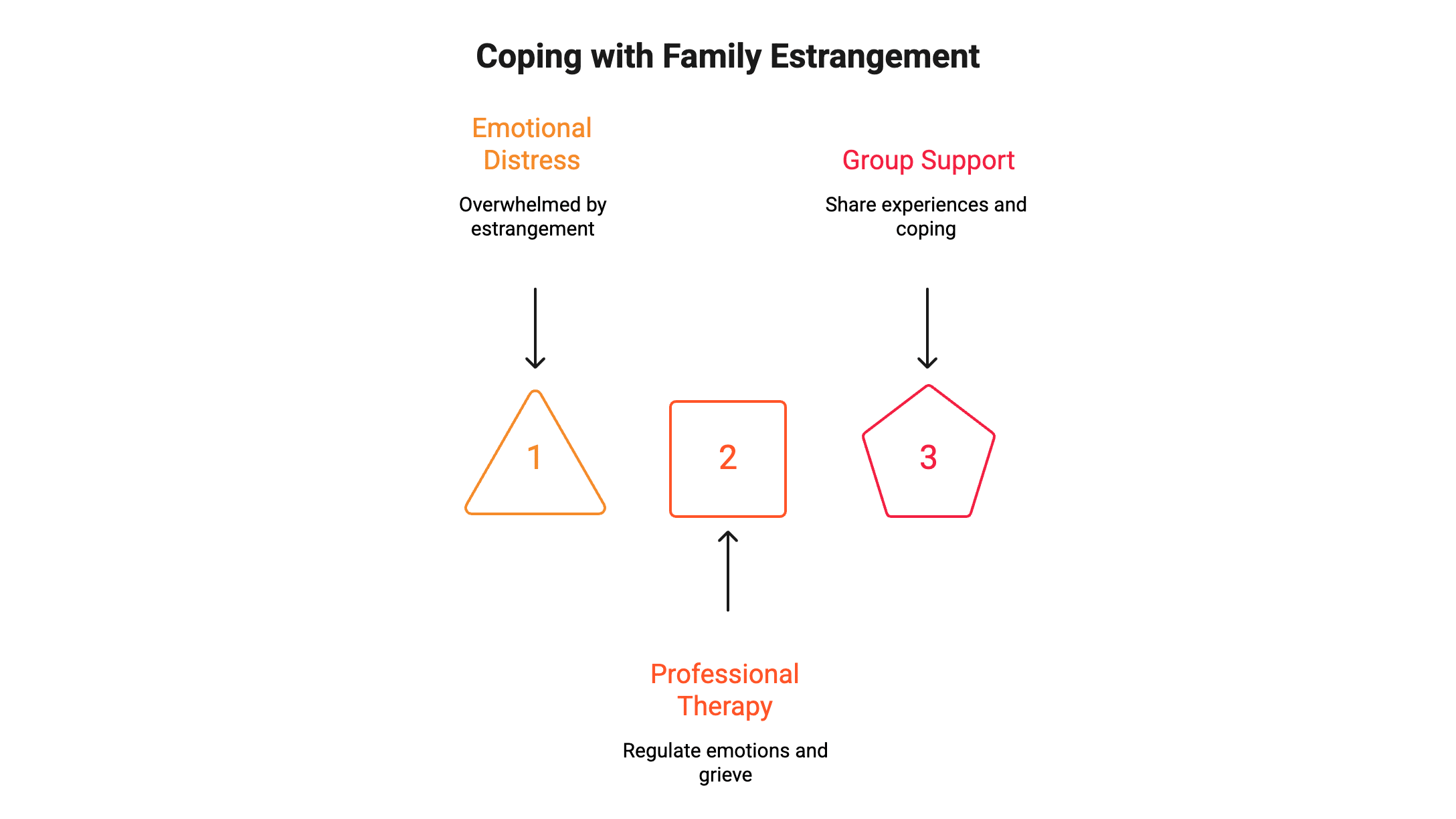Family Estrangement: Why Do Adult Children Cut Ties?
What is family estrangement, in simple terms?
In plain terms, family estrangement is when a family member—often an adult child—chooses reduced, limited, or no contact to protect their well‑being. Family estrangements can involve not only parents and adult children, but also siblings and extended family members, reflecting the complex dynamics that can affect various relationships within a family.
Common drivers of estrangement include abuse, neglect, and betrayal of trust, which can deeply impact familial bonds.
It isn’t always permanent. Contact can shift over time as people set clearer boundaries, feel safer, or see meaningful behavior change. A 2023 national survey in Journal of Marriage & Family found that parent–adult child relationships range from close contact to limited or no contact, and that patterns can change across the life course, with young adults among those who experience these patterns of contact and estrangement. A significant percentage of estrangements, particularly between parents and children, can be resolved within ten years.
What are the most common reasons adult children go no‑contact?
Adult children usually step back after repeated boundary violations, ongoing conflict, a difficult relationship, or value clashes that make contact feel unsafe or chronically draining. The patterns below show up again and again in research and in therapy rooms, including substance abuse, neglectful behavior, and divorce as issues that can lead to estrangement. Many people experience these challenges in their families.
What happens when boundaries are ignored or violated?
When requests like “please don’t criticize my partner” or “no yelling on calls” are dismissed, people learn that limit‑setting doesn’t work. Over time, especially after a long period of repeated violations, they may move to limited or no contact as the only boundary that holds. For some, estrangement develops gradually over a few years as issues accumulate. Long‑term relational strain—not one bad day—most often drives the decision. Findings from a 2015 study in Journal of Marriage & Family highlight how persistent tension and unresolved conflict can predict estrangement.
How do abuse, neglect, or chronic conflict drive distance?
Histories of emotional abuse, sexual abuse, physical, or financial abuse—and homes where conflict never cools—predict estrangement more than ordinary disagreements. Both mothers and fathers can be sources of abuse or neglect that lead to estrangement. A longitudinal qualitative study points to slow, cumulative erosion of contact rather than sudden breakups.
Painful memories of abuse or neglect often linger, influencing the decision to step back. Adult children commonly report years of trying to repair the relationship before stepping back.
How do control, parentification, or enmeshment play a role?
If one or both parents control major life choices, lean on a child like a surrogate partner or therapist, or expect constant loyalty over autonomy, the adult child may disconnect to reclaim space and privacy. Each person’s experience of these dynamics is unique.
How do value clashes (politics, religion, identity) fuel rifts?
Clashes about partners, parenting, religion, or politics aren’t new. What matters is respect. When an adult child’s identity (for example, LGBTQ+ status or chosen faith) is dismissed or attacked, distance can become a safety response rather than a “phase.” LGBTQ people are especially vulnerable to value-based estrangement from their parents, highlighting the need for understanding and support in these family dynamics.
In a survey, a substantial portion of LGBTQ individuals reported estrangement from family members compared to heterosexual individuals. Other factors, such as generational differences or cultural expectations, can also fuel rifts and contribute to estrangement.
How do addiction or untreated mental illness affect safety and trust?
Substance abuse and untreated mental health conditions can fuel broken promises, volatility, or unsafe environments. These issues can create emotionally dangerous family environments, making estrangement necessary to protect one’s emotional well-being. Many estranged individuals report that their relationships have improved since limiting or cutting off contact with family members. Adult children may choose distance until there is consistent treatment and accountability.
How do financial strings or expectations create pressure?
Gifts with strings, surprise debts, or pressure to support parents financially can turn money into leverage. Disputes over a family business, such as disagreements about roles, inheritance, or hiring decisions, can also create significant pressure and contribute to estrangement. Clear terms—or saying no—reduces resentment; if that fails, distance creates breathing room.
What does the “last straw” usually look like?
There’s rarely a single moment. More often, the “final straw” is the next dismissal after many attempts to set limits—like disrespecting a partner at a holiday, breaking a childcare boundary, or pushing hot‑button topics after being asked to stop. Not everyone experiences the final straw in the same way; each relationship’s breaking point is unique and shaped by its own history and dynamics. Large, multi‑year studies suggest estrangement is typically the culmination of chronic strain, not an impulsive cut‑off.
How do culture and identity shape decisions to step back?
Cultural expectations about filial duty can collide with a need for psychological safety. In the vast majority of cultures, there is a strong expectation of family loyalty, making estrangement especially difficult and often viewed as a serious breach of social norms. In immigrant families, acculturative family distancing—gaps in language, values, and expectations—can heighten conflict and risk for mental health problems, which sometimes leads to partial or full estrangement.
Cultural attitudes influence the frequency of estrangement, with individualistic cultures experiencing higher rates. Cultural differences can also result in fractured families when expectations about family roles and obligations clash, further complicating relationships and the potential for reconciliation.
Is estrangement always permanent—or can contact change?
Short answer: it can change. People often shift from no contact to limited or structured contact when safety improves, apologies are paired with behavior change, and boundaries are honored consistently. Improved family communication is often key to resuming contact between estranged family members, as open and honest dialogue can help rebuild trust and address unresolved issues. Newer longitudinal work suggests that emotional closeness—more than big life events—predicts whether contact gradually resumes.
How do you set healthy boundaries without cutting ties?
Start small and be specific. It makes sense to set boundaries for your own well-being. Pick one boundary, state it in simple words, and name the next step if it’s crossed. Examples: limit hot‑spot topics, set time boxes for visits, and keep some conversations in writing so there’s a record.
Effective communication strategies include using ‘I’ statements and empathetic language to avoid blame. Remember, boundaries may also be necessary with other family members, not just parents. Practice a short script and stick to it; consistency beats intensity.
What if you’re considering reconnection—how do you test the waters safely?
Go slow and make it conditional. Try a letter or email first. State one boundary and ask for a small behavior test (for example, “Let’s meet for 45 minutes; politics and religion are off‑limits.”). In fractured families, daughters may have unique considerations or challenges when testing reconnection, as gender differences can influence how reconnection is approached. Watch for accountability—not just apologies, but new behavior over time. If the test goes well, take the next small step.
How can therapy help you cope day to day?
Seeking professional help can be crucial for coping with family estrangement. Therapy can help you regulate strong emotions, grieve what you hoped the relationship would be, and plan specific conversations. Group support, including group therapy, also shows promise; one 2022 evaluation found a brief, six‑session group reduced distress for estranged adults and improved coping.
What words can you use to state your boundary? (Short scripts)
- “I’m not available for conversations where I’m criticized. If it starts, I’ll end the call.”
- “I’m willing to meet for one hour in a public place. Politics/religion are off‑limits.”
- “If you can stick to the plan for three visits, we can consider longer time together.”
- “As two family members, I think it’s important we respect each other’s boundaries. If either of us feels uncomfortable, we can take a break and talk later.”
- “Since my parents rejected me, I need to protect my emotional well-being. I’m open to communication only if it’s respectful and free from past criticisms.”
When should you seek immediate support?
If you are experiencing family estrangement and feel unsafe, or if you fear for your safety, are experiencing stalking/harassment, or feel suicidal, reach out for immediate help. (In emergencies, call 911.)
How does estrangement relate to health and stress over time?
Research is mixed but growing. Some studies find that strained or broken ties link to worse mental and physical health for parents and adult children, while others point to relief when boundaries reduce chronic conflict. Newer work suggests distinct health effects for each generation when maternal ties are broken.
Estrangement can activate a grief response, as individuals often perceive it as a loss they were unprepared for. Recent new research from Cornell University highlights the significant health impacts of familial estrangement, especially in fractured families, and underscores the importance of understanding these dynamics. Intergenerational research also connects a parent’s early adversity to later estrangement risk in adulthood.
Potential Next Steps with the Therpay Group of DC
Mixed feelings are normal—grief, anger, relief, and even hope can coexist. If you live in the DC area and want support that respects your boundaries, therapists at the Therapy Group of DC (Dupont Circle) can help you sort next steps at your pace, whether that’s maintaining distance, exploring limited contact, or preparing for a careful reconnection.
Frequently Asked Questions About Family Estrangement
What are some common family issues that lead to estrangement?
Family issues such as emotional abuse, neglectful behavior, substance abuse, and chronic conflict often contribute to family estrangement. Additionally, clashes over values, identity, and unresolved painful memories can deepen rifts between family members.
How does family estrangement affect mental health?
Estrangement can have complex effects on mental health. While the rejected family member may experience loneliness, grief, and decreased well-being, the initiator often finds relief from stress and emotional danger. Professional help and group therapy can support coping and healing.
Can estranged family members reconcile after a long period of no contact?
Yes, reconciliation is possible in many cases. Research shows that many estranged family members eventually reconnect, often facilitated by therapy, improved family communication, and mutual respect for boundaries. Reconciliation requires a new perspective and willingness to build healthier relationships.
How do friends play a role during family estrangement?
Friends often become a vital support network for estranged individuals, providing emotional care and a sense of chosen family. This support can help mitigate the social isolation that sometimes accompanies estrangement.
Who is Joshua Coleman and what is his contribution to understanding family estrangement?
Joshua Coleman is a psychologist and author who has extensively studied family estrangement. His work focuses on helping parents and adult children navigate estrangement, repair fractured families, and understand the complex dynamics involved in family relationships.
What is meant by the “messy reality” of family estrangement?
The “messy reality” refers to the complicated, often painful nature of family estrangement, where emotions, past trauma, and social expectations intertwine. It acknowledges that estrangement is rarely clear-cut and involves navigating difficult feelings and relationships.
How can understanding fault lines in family relationships help?
Recognizing fault lines—deep-seated issues and patterns within family relationships—can help individuals understand the root causes of estrangement. This awareness can guide healing efforts and promote healthier communication and boundaries.
How does the loss of a mom affect family estrangement?
The loss of a mom, whether through death or estrangement, can intensify grief and complicate family dynamics. It often brings a unique set of emotional challenges that require empathy, support, and sometimes professional guidance to process.


